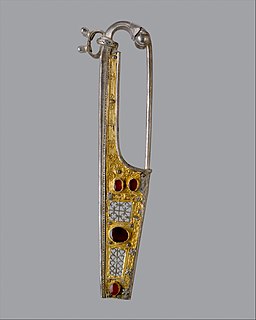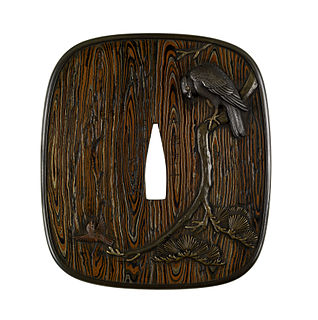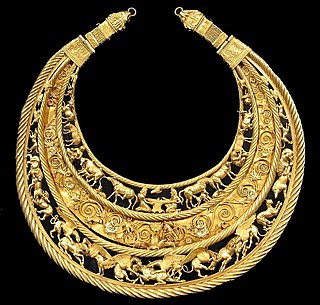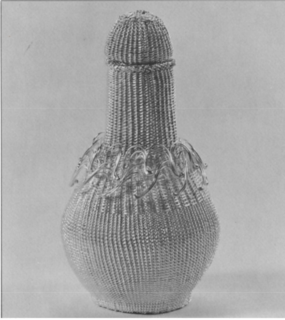
Jewellery (UK) or jewelry (U.S.) consists of decorative items worn for personal adornment, such as brooches, rings, necklaces, earrings, pendants, bracelets, and cufflinks. Jewellery may be attached to the body or the clothes. From a western perspective, the term is restricted to durable ornaments, excluding flowers for example. For many centuries metal such as gold often combined with gemstones, has been the normal material for jewellery, but other materials such as glass, shells and other plant materials may be used.

Engraving is the practice of incising a design onto a hard, usually flat surface by cutting grooves into it with a burin. The result may be a decorated object in itself, as when silver, gold, steel, or glass are engraved, or may provide an intaglio printing plate, of copper or another metal, for printing images on paper as prints or illustrations; these images are also called "engravings". Engraving is one of the oldest and most important techniques in printmaking. Wood engraving is a form of relief printing and is not covered in this article.

Metalworking is the process of shaping and reshaping metals to create useful objects, parts, assemblies, and large scale structures. As a term it covers a wide and diverse range of processes, skills, and tools for producing objects on every scale: from huge ships, buildings, and bridges down to precise engine parts and delicate jewelry.

A silversmith is a metalworker who crafts objects from silver. The terms silversmith and goldsmith are not exactly synonyms as the techniques, training, history, and guilds are or were largely the same but the end product may vary greatly as may the scale of objects created.

A goldsmith is a metalworker who specializes in working with gold and other precious metals. Nowadays they mainly specialize in jewelry-making but historically, goldsmiths have also made silverware, platters, goblets, decorative and serviceable utensils, and ceremonial or religious items.

A brooch is a decorative jewelry item designed to be attached to garments, often to fasten them together. It is usually made of metal, often silver or gold or some other material. Brooches are frequently decorated with enamel or with gemstones and may be solely for ornament or serve a practical function as a clothes fastener. The earliest known brooches are from the Bronze Age. As fashions in brooches changed rather quickly, they are important chronological indicators. In archaeology, ancient European brooches are usually referred to by the Latin term fibula.

Repoussé or repoussage is a metalworking technique in which a malleable metal is shaped by hammering from the reverse side to create a design in low relief. Chasing or embossing is a similar technique in which the piece is hammered on the front side, sinking the metal. The two techniques are often used in conjunction.

Mokume-gane (木目金) is a Japanese metalworking procedure which produces a mixed-metal laminate with distinctive layered patterns; the term is also used to refer to the resulting laminate itself. The term mokume-gane translates closely to "wood grain metal" or "wood eye metal" and describes the way metal takes on the appearance of natural wood grain. Mokume-gane fuses several layers of differently coloured precious metals together to form a sandwich of alloys called a "billet." The billet is then manipulated in such a way that a pattern resembling wood grain emerges over its surface. Numerous ways of working mokume-gane create diverse patterns. Once the metal has been rolled into a sheet or bar, several techniques are used to produce a range of effects.

Filigree is a form of intricate metalwork used in jewellery and other small forms of metalwork.

Damascening is the art of inlaying different metals into one another—typically, gold or silver into a darkly oxidized steel background—to produce intricate patterns similar to niello. The English term comes from a perceived resemblance to the rich tapestry patterns of damask silk. The term is also used to describe the use of inlaid copper interconnects in integrated circuits.

Jewellery as an art form originated as an expression of human culture. Body ornamentation, one purpose of jewellery, has been known since at least the Stone Age. The history of jewellery in Ukraine reflects the influence of many cultures and peoples who have occupied the territory in the past and present.

Jewellery design is the art or profession of designing and creating jewellery. This is one of civilization's earliest forms of decoration, dating back at least 7,000 years to the oldest known human societies in Indus Valley Civilization, Mesopotamia and Egypt. The art has taken many forms throughout the centuries, from the simple beadwork of ancient times to the sophisticated metalworking and gem cutting known in the modern day.

Wire sculpture is the creation of sculpture or jewelry out of wire. The use of metal wire in jewelry dates back to the 2nd Dynasty in Egypt and to the Bronze and Iron Ages in Europe. In the 20th century, the works of Alexander Calder, Ruth Asawa, and other modern practitioners developed the medium of wire sculpture as an art form.
Iranian handicrafts are handicraft or handmade crafted works originating from Iran.

Mary Lee Hu is an American artist, goldsmith, and college level educator known for using textile techniques to create intricate woven wire jewelry.

Openwork or open-work is a term in art history, architecture and related fields for any technique that produces decoration by creating holes, piercings, or gaps that go right through a solid material such as metal, wood, stone, pottery, cloth, leather, or ivory. Such techniques have been very widely used in a great number of cultures.

The Middle Ages was a period that spanned approximately 1000 years and is normally restricted to Europe and the Byzantine Empire. The material remains we have from that time, including jewelry, can vary greatly depending on the place and time of their creation, especially as Christianity discouraged the burial of jewellery as grave goods, except for royalty and important clerics, who were often buried in their best clothes and wearing jewels. The main material used for jewellery design in antiquity and leading into the Middle Ages was gold. Many different techniques were used to create working surfaces and add decoration to those surfaces to produce the jewellery, including soldering, plating and gilding, repoussé, chasing, inlay, enamelling, filigree and granulation, stamping, striking and casting. Major stylistic phases include barbarian, Byzantine, Carolingian and Ottonian, Viking, and the Late Middle Ages, when Western European styles became relatively similar.

Sukashibori is the Japanese term for openwork or pierced work, using various techniques in metalworking and other media, in which the foreground design is left intact, while background areas are cut away and removed. The resulting piece becomes see-through (sukashi) and hence the name.

Scottish jewellery is jewellery created in Scotland or in a style associated with Scotland, which today often takes the form of the Celtic style. It is often characterised by being inspired by nature, Scandinavian mythology, and Celtic knot patterns. Jewellery has a history in Scotland dating back to at least the Iron Age.

Jan Yager is an American artist who makes mixed media jewelry. She draws inspiration from both the natural world and the lived-in human environment of her neighborhood in Philadelphia, Pennsylvania, emphasizing that art is a reflection of both time and place. She has incorporated rocks, bullet casings, and crack cocaine vials into her works, and finds beauty in the resilience of urban plants that some would consider weeds.



















